中国文化外译论文
具有中国文化特色词语的翻译研究

- 208-校园英语 / 翻译研究具有中国文化特色词语的翻译研究银川能源学院外国语学院/侯智媛【摘要】近年来,各国主流媒体对富有中国文化特色词的翻译成为令人感兴趣的话题,不断引发网友及翻译工作者的关注。
本项目旨在研究涉及中国文化特色词的翻译方法,为译者能够更好地翻译中国文化特色词提供参考指导,促进中国特色文化的输出和传播。
【关键词】中国文化 特色词语 翻译愈来愈多的西方学者意识到中国不再是“失声的中国”,中国文化的强势,让他们把目光转移到汉语研究上,随着中国与世界各国关系的友好和融洽,以及国外孔子学院的遍地开花,掀起了一股又一股“中华热”与“汉语热”。
我们应该把握契机,加强中国文化的对外传播,促进与各国人民和民族的交流,使其他民族更加深刻地了解中国,从而,促使世界各国之间的和谐发展。
从这方面来讲,中国文化特色词语的翻译研究无疑是介绍中国最直接的表达方式。
虽然,我国翻译界在这个领域的研究已经取得了丰硕的成果,但是,具有中国文化特色词语的翻译无论是理论研究还是翻译实践都还存在着诸多不尽人意的地方。
具有中国特色的新词语反映了我国特有的事物和现象,蕴含中国民族特色,其翻译具有自身的特殊性,即具有“实效性、创造性和不可替换性”等特点。
因此,相对应的英译几乎没有任何先例可供借鉴,这就需要译者的独创。
同时,由于外译的需要,新词语翻译的实效性就显得尤为重要。
但由于译文的受众目标,多为母语为非汉语的外国读者,因此,信息的反馈比较滞后,难以针对读者的接受度对问题译词进行改译或打磨润色,错译、误译就在所难免。
因此,具有中国文化特色词语的翻译理论及其策略研究还有很大的不足,值得我们不断地去打磨和探索,用承优和创新的精神去填补空白。
一、中国文化特色词语的概念及内涵中国文化特色词是中国英语研究中相当重要的一部分。
中国文化特色词是表达中国文化中的特有事物,其中蕴藏着中国千百年文化的内涵,即发源于中国,基于中国特色文化、社会、人文环境等所产生,仅存在于中国的事物、事件等的词汇。
论中国典籍外译
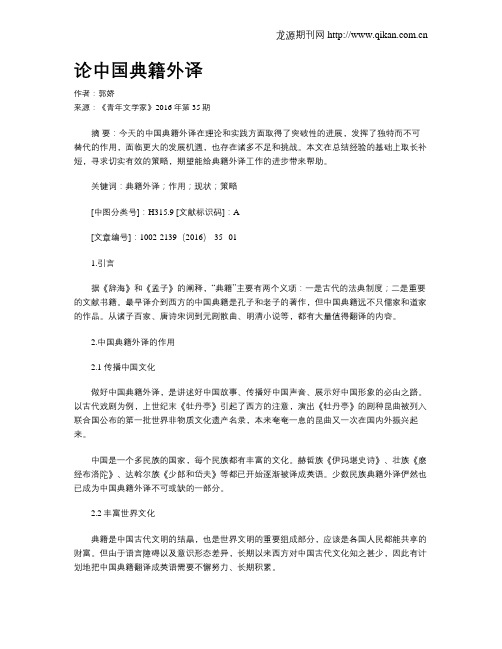
论中国典籍外译作者:郭娇来源:《青年文学家》2016年第35期摘要:今天的中国典籍外译在理论和实践方面取得了突破性的进展,发挥了独特而不可替代的作用,面临更大的发展机遇,也存在诸多不足和挑战。
本文在总结经验的基础上取长补短,寻求切实有效的策略,期望能给典籍外译工作的进步带来帮助。
关键词:典籍外译;作用;现状;策略[中图分类号]:H315.9 [文献标识码]:A[文章编号]:1002-2139(2016)-35--011.引言据《辞海》和《孟子》的阐释,“典籍”主要有两个义项:一是古代的法典制度;二是重要的文献书籍。
最早译介到西方的中国典籍是孔子和老子的著作,但中国典籍远不只儒家和道家的作品。
从诸子百家、唐诗宋词到元剧散曲、明清小说等,都有大量值得翻译的内容。
2.中国典籍外译的作用2.1 传播中国文化做好中国典籍外译,是讲述好中国故事、传播好中国声音、展示好中国形象的必由之路。
以古代戏剧为例,上世纪末《牡丹亭》引起了西方的注意,演出《牡丹亭》的剧种昆曲被列入联合国公布的第一批世界非物质文化遗产名录,本来奄奄一息的昆曲又一次在国内外振兴起来。
中国是一个多民族的国家,每个民族都有丰富的文化。
赫哲族《伊玛堪史诗》、壮族《麽经布洛陀》、达斡尔族《少郎和岱夫》等都已开始逐渐被译成英语。
少数民族典籍外译俨然也已成为中国典籍外译不可或缺的一部分。
2.2丰富世界文化典籍是中国古代文明的结晶,也是世界文明的重要组成部分,应该是各国人民都能共享的财富。
但由于语言障碍以及意识形态差异,长期以来西方对中国古代文化知之甚少,因此有计划地把中国典籍翻译成英语需要不懈努力、长期积累。
在全球化的背景下,尤其是随着中国文化“走出去”战略的提出和实施,“中译英”越发重要和迫切。
中国典籍,浩瀚如海,灿似珍珠,把中华民族富有特色的文化精髓译成英语,让世界更了解中国,让中国文化参与全球文化交流对充实人类文化极其重要。
3.中国典籍外译的发展现状中国典籍外译本来是个冷门方向,但近年来该领域的翻译实践者、理论研究者、学科教学者层出不穷,古典散文、诗歌、戏剧、小说外译等各领域齐头并进。
四级中国文化英语作文模板

四级中国文化英语作文模板Title: The Significance of Chinese Culture in the Global Context。
Introduction。
Chinese culture, with its rich history and diverse traditions, holds a significant place in the global context. From its ancient philosophy and art to its modern innovations and influence, Chinese culture has made a profound impact on the world. In this essay, we will explore the significance of Chinese culture in the global context, examining its influence on various aspects of society.Historical and Philosophical Influence。
Chinese culture has a long and illustrious history, dating back thousands of years. Throughout history, Chinese philosophy, such as Confucianism and Taoism, has had a profound impact on the world. The teachings of Confucius, with their emphasis on morality, family values, and social harmony, have influenced not only Chinese society but also the global understanding of ethics and governance. Similarly, the principles of Taoism, with their focus on balance, harmony, and nature, have inspired thinkers and artists around the world.Art and Literature。
中国文化“走出去”视域下中国文化典籍翻译——以《论语》英译为例

1引言翻译,对于提升跨文化传播的广度及深度均有重要影响。
随着海外了解中国文化的需求增强,学习汉学热潮再度兴起。
中国文化如何更好地“走出去”,从官方至民间,人们普遍希望通过译介中华经典的方式来实现。
如何做好相关译介,用外语发声,表达价值诉求,减少他国误读,是当今时代的一项重要课题。
习近平总书记曾在纪念孔子诞辰2565周年的国际学术研讨会上说:“研究孔子、研究儒学,是认识中国人的民族特性、认识当今中国人精神世界历史来由的一个重要途径。
”《论语》作为儒家经典,在学术界、传播界及海外文化圈享有盛誉,是“中华文化典籍传播”的标志。
本文通过调查《论语》不同英译本在谷歌学术引擎的受关注情况,结合亚马逊图书网上的销售情况进行数据分析,并对被学界认可、受关注度较高的两个译本的翻译情况进行剖析,探析其翻译特点、策略,从而针对性地提出建议。
2中国文化典籍英译问题研究中国文化典籍的译介是我国文化“走出去”的重要途径。
在翻译中,采取归化还是异化的翻译策略仍是译者需要思考的问题。
众多学者也对此进行了相关研究。
王妍(2019)认为,由于外国读者对中国文化的误读,很大程度上是因为不合理的翻译使得中国文化不能很好地走向国际舞台。
祝东江(2018)认为,中国文化需要通过翻译在世界范围内获得较广泛的理解与接受,然而各类对外翻译中,硬译、乱译及“奇葩”翻译层出不穷。
在译本的认同性及翻译策略上,谢天振指出:西方对于中国文学作品的忠实译本并未完全理解。
在译介中国文学时常用归化、删节,故译者应更新翻译观念,不能贪大、贪全,应更多地进行节译和改写。
胡安江(2010)认为:真正具有价值的翻译需要汉学家和中国学者共同努力,尽量采用归化策略。
许钧(2014)认为:对外译介是将中华民族最核心、最精华的文化思想与价值观念,通过目的语国家受众较易接受并乐于接受的方式逐步推介。
译者需加强史料搜集梳理,以正确的文化史观,准确翻译中国文化作品。
3《论语》翻译出版及代表性版本情况3.1《论语》翻译出版史《论语》外译,最早可追溯至16世纪末期,先后有众多西方传教士、汉学家、哲学家、文学家、海内外华人学者等对《论语》进作者简介:邓凯月,翻译硕士在读。
文化翻译论文:文化翻译理论视域下的汉语典籍英译

文化翻译论文:文化翻译理论视域下的汉语典籍英译【中文摘要】中国典籍是中国传统文化的集中体现,其就是要建构全球文化的多样性,维护民族文化身份,促进文化交流。
目前不少学者和翻译家从事典籍外译研究,虽迈出了可喜的一步,但仍存在不少问题。
综观国内外,尤其是国外的中国典籍英译文本,相当一部分是在依循西方哲学、神学、伦理学的框架、标准、范畴、概念,乃至意识形态,对中国传统哲学独特的内涵进行有条理的,概念性的切割、析解、组装。
这样的译文不可能如实反映中华民族历史的本来面目、社会文化的发展,也不可能紧扣中国人的思想、意识形态的真实主题和内在规律。
因此,该采取何种方式向西方国家介绍中国的文化成为了争议最大的问题。
后殖民理论大师霍米巴巴认为发达国家的强势文化与发展中国家的弱势文化不该是支配与被支配、控制与被控制的关系,他提出的文化翻译理论作为一种文化存活策略,就是要提倡文化的多样性,消解西方(欧美)中心论及其二元对立,重建“少数族”的主体性并帮助他们发出自己的声音。
巴巴的文化翻译理论拒绝将原作按照目标语言文化的规范进行理解,而是主张将各种异质文化混杂在一起,使一种文化的成分传入到另一种文化中去,从而建立一个模糊的“第三空间”,即忠实原作内容,又能奇妙地传递原作的风格和神韵,最终动摇霸权主义,维护民族文化身份,建构全球文化多样性。
这对中国典籍英译有很强的指导意义。
因此,本文以后殖民理论家霍米巴巴的文化翻译理论为依托,通过其混杂和第三空间的颠覆策略,来论证当今译者该采取文化翻译的方式,如实地对外翻译和宣传汇集华夏文明精髓的汉文化典籍,在话语实践上做到你中有我,我中有你的状态,凸显文化差异,达到东西方互相理解与和平对话,最终使我们辉煌悠久、博大精深的华夏文明被世界所了解并接受,促进文化的沟通和交流。
笔者以杨宪益夫妇翻译的《儒林外史》英译本为例,从译者的文化身份,文学规范和文化层面三个方面分析,证明文化翻译的可取性。
中国典籍英译采取文化翻译的策略能做到形神兼备,忠实源语形象,保持中国文化个性,减少文化亏损,信于中国文化的核心,再现中国文化精髓,传播中国文化。
现代阐释学视角下中国文论外译研究--以《文心雕龙》三个英译本为例

现代阐释学视角下中国文论外译研究—以《文心雕龙》三个英译本为例—戴文静摘要:作为中华文论龙祖的《文心雕龙》被公认为最宜优先成为重新诠释、现代应用、向外输出的文学理论。
本文通过梳理《文心雕龙》的译介谱系,考察《文心雕龙》三个代表性译本,发现施友忠采取的“译释并举”和宇文所安采取的“译评相融”的翻译策略侧重于译本的学术性阐释,使其具有较高的文学性及学术价值,更易引起海外学界及汉学家的关注和探讨,有助于推进《文心雕龙》海外传译的经典化进程,为中西文论的平等对话铺设道路;而偏向于大众读者优先的黄兆杰倾向于采用文化性阐释策略,更侧重于译本的现代审美价值及文化取向,他的译本优雅可读,通俗易懂,对《文心雕龙》海外传译的普及化起到了很好的促进作用。
《文心雕龙》译声复调,针对不同读者对象的各译本互为补充,不同层次译本的复调调和可以满足不同审美层次受众的需求,有利于中国古代经典文论在异域的传播与接受,为海外龙学研究提供了有力保证。
关键词:文心雕龙;中国文论;译介;阐释;龙学[中图分类号]H315.9DOI:10.12002/j.bisu.309[文献标识码]A[文章编号]1003-6539(2020)06-0068-14引言在“一带一路”倡议及“中国文化走出去”的时代潮流之下,中国文论的译介研究已成为当前学界亟待关注的重要议题。
20世纪50年代,中国文论摆脱了经学和文化研究的附庸地位,逐渐受到诸多海外学者的青睐。
西方传统对系统诗学一直评价甚高,《文心雕龙》因其体系详备引起众多西方学者的关注。
海外凡涉及中国传统文学、批评和理论的论著,几乎都会提及并引用《文心雕[基金项目]本文为2019年度教育部人文社会科学研究青年基金项目“《文心雕龙》在英语世界的译介与接受研究”(项目编号:19YJCZH019)和2020年中国博士后科学基金项目“英语世界《文心雕龙》百年传播研究”(项目编号:2020M670955)阶段性研究成果。
中国文化“走出去”之外宣翻译策略探讨

2019年4月重庆工商大学学报(社会科学版)第36卷第2期Apr.2019Journal of Chongqing Technology and Business University (Social Sciences Edition )Vol.36 NO.2doi : 10.3696/j.issn.1672⁃0598.2019.02.018∗[收稿日期]2018⁃10⁃28[基金项目]教育部人文社会科学研究(西部)青年基金项目(18XJC740001)“‘中国关键词’的翻译与传播研究”;重庆市教育科学“十三五”规划课题(2017⁃GX⁃315)“人工智能时代翻译教学中审辨思维(critical thinking )能力培养研究”[作者简介]骆萍(1979—),女;重庆工商大学外语学院副教授,主要从事翻译史和社会翻译学研究。
中国文化“走出去”之外宣翻译策略探讨∗骆 萍(重庆工商大学外语学院,重庆400067)摘 要:在全球化日益加快、文化多元共存的语境下,中国文化走向世界成为国家文化发展战略的重要内容。
对外宣传的目的是让外国受众准确理解原文的信息,以增强国家文化软实力和国际话语权。
鉴于此,在翻译实践中,应遵循外宣翻译“三原则”,以英语目的语为归依,使受众能够理解并接受译文,同时最大限度地保留中国文化和政治话语特色。
关键词:中国文化“走出去”;外宣翻译;党政文件;翻译原则与策略中图分类号:H059 文献标志码:A 文章编号:1672⁃0598(2019)02⁃0122⁃07 近年来,随着中国经济的快速增长和综合实力的日益增强,中国在国际舞台上扮演着越来越重要的角色,世界各国对中国的发展道路充满好奇,希望了解和借鉴其发展模式。
与此同时,在全球化大背景下,中国进入公共外交时代,加强文化软实力建设,让世界了解中国,中国文化“走出去”被提到了国家战略层面上。
中国文化是中华民族思想感情和实践经验的智慧结晶,代表着中华民族的精神追求和精神标识,习近平总书记在《关于进一步加强和改进中华文化走出去工作的指导意见》中倡导“向世界阐释推介更多具有中国特色、体现中国精神、蕴藏中国智慧的优秀文化……增强中华文化亲和力、感染力、吸引力”。
中国文学外译的意义与价值

中国文学外译的意义与价值摘要:一、引言二、中国文学外译的意义1.提升中国文化影响力2.丰富世界文学宝库3.促进国际文化交流三、中国文学外译的价值1.传播中华优秀传统文化2.展现中国现实生活3.提升国际形象四、面临的挑战与应对策略1.语言差异2.文化隔阂3.翻译人才的培养五、结论正文:随着全球化的不断深入,中国文学外译的意义与价值愈发凸显。
外译工作不仅有助于提升中国文化在全球的影响力,丰富世界文学宝库,还能促进国际文化交流,增进各国人民之间的友谊。
首先,中国文学外译具有重要的意义。
一方面,通过翻译优秀的中国文学作品,我们可以让世界各地的读者了解和欣赏到中华文化的独特魅力,从而提升中国文化在全球的影响力。
另一方面,将中国文学推向世界,有助于丰富世界文学的多样性,为世界文学宝库增添新的财富。
同时,中国文学外译还能促进国际文化交流,推动世界各国之间的相互理解和尊重。
其次,中国文学外译具有显著的价值。
通过翻译,我们可以将中华优秀传统文化传播到世界各地,让更多人领略到中华民族的智慧。
此外,外译工作还能展现当代中国的生活面貌,帮助国际社会了解中国的发展成就和社会进步。
在这个过程中,中国文学也成为了一张亮丽的国家名片,有助于提升中国的国际形象。
然而,中国文学外译过程中也面临着诸多挑战,如语言差异、文化隔阂等。
为应对这些挑战,我们需要加强翻译人才的培养,提高翻译质量。
同时,译者应充分了解两种文化,善于挖掘作品中的文化内涵,并在翻译过程中注重文化融合与创新。
总之,中国文学外译具有重要意义和价值。
我们应充分认识其重要性,努力克服困难,推动中国文学在世界舞台上发扬光大。
中国典籍外译
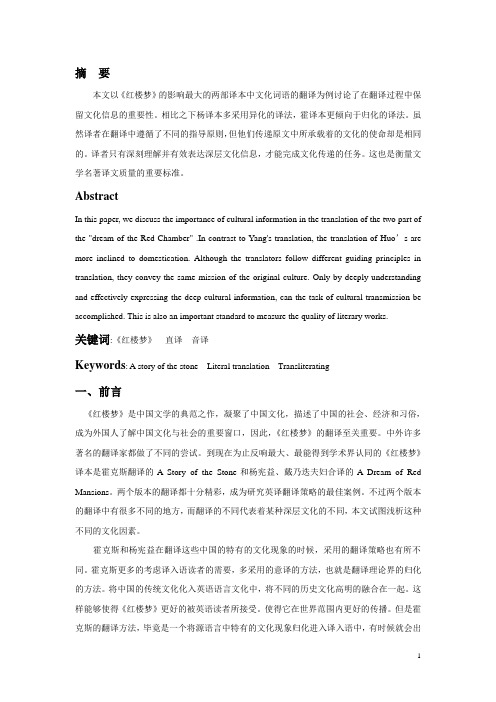
摘要本文以《红楼梦》的影响最大的两部译本中文化词语的翻译为例讨论了在翻译过程中保留文化信息的重要性。
相比之下杨译本多采用异化的译法,霍译本更倾向于归化的译法。
虽然译者在翻译中遵循了不同的指导原则,但他们传递原文中所承载着的文化的使命却是相同的。
译者只有深刻理解并有效表达深层文化信息,才能完成文化传递的任务。
这也是衡量文学名著译文质量的重要标准。
AbstractIn this paper, we discuss the importance of cultural information in the translation of the two part of the "dream of the Red Chamber" .In contrast to Yang's translation, the translation of Huo’s are more inclined to domestication. Although the translators follow different guiding principles in translation, they convey the same mission of the original culture. Only by deeply understanding and effectively expressing the deep cultural information, can the task of cultural transmission be accomplished. This is also an important standard to measure the quality of literary works.关键词:《红楼梦》直译音译Keywords: A story of the stone Literal translation Transliterating一、前言《红楼梦》是中国文学的典范之作,凝聚了中国文化,描述了中国的社会、经济和习俗,成为外国人了解中国文化与社会的重要窗口,因此,《红楼梦》的翻译至关重要。
中华文化英文作文

中华文化英文作文英文:As a Chinese person, I am proud of my country's rich and diverse culture. Chinese culture has a long history and has influenced many other cultures around the world. One of the most important aspects of Chinese culture is the emphasis on family and community. We value ourrelationships with our loved ones and respect our elders.Another important aspect of Chinese culture is the emphasis on education. We believe that education is the key to success and that we should always strive to learn new things. This is why many Chinese parents place a strong emphasis on their children's education and encourage them to study hard and achieve their goals.In addition to family and education, Chinese culture is also known for its delicious cuisine, beautiful art and architecture, and traditional festivals and customs. Forexample, the Chinese New Year is a time for families to come together and celebrate with food, fireworks, and other festivities.Overall, I believe that Chinese culture is a wonderful and unique aspect of our world. It is something that should be celebrated and shared with others.中文:作为一个中国人,我为我的国家拥有丰富多样的文化而感到自豪。
中国文化外译的意义

中国文化外译的意义摘要:一、引言:中国文化外译的背景与重要性二、中国文化外译的意义1.提升国际影响力2.促进文化交流与认同3.丰富目标语言文化4.增强民族自信三、面临的挑战与应对策略1.语言差异与障碍2.文化内涵的传达3.译者素质与培训4.社会各界支持与协作四、结论:中国文化外译的前景与挑战正文:随着全球化的深入推进,中国文化外译的重要性日益凸显。
在外译的过程中,不仅要把文字准确地翻译出来,还要充分传达文化内涵,让国外读者能够理解和接受。
中国文化外译的意义主要体现在以下几个方面。
首先,中国文化外译有助于提升国际影响力。
通过翻译,中国的传统文化、文学作品、哲学思想等走向世界,让更多外国人了解和认识到中国的优秀文化。
这对于提升国家形象、增强国际地位具有重要意义。
其次,中国文化外译有助于促进文化交流与认同。
文化交流是构建人类命运共同体的重要桥梁。
通过外译,中外文化可以相互借鉴、融合,形成更加丰富的文化体系。
同时,外译作品也能增强外国读者对中国的文化认同,促进国际间的友好合作。
再次,中国文化外译有助于丰富目标语言文化。
翻译是将一种语言文化的优秀成果引入另一种语言文化的重要途径。
随着中国文化的外译,许多优秀的文化作品得以在世界各地传播,为外国语言文化的发展注入了新的活力。
最后,中国文化外译有助于增强民族自信。
在文化外译的过程中,我们可以看到中国文化的独特魅力和价值。
这种文化自信有助于提高民族自豪感,激发全体国民为国家和民族的发展而努力奋斗。
然而,中国文化外译也面临着诸多挑战,如语言差异、文化内涵的传达、译者素质等。
为应对这些挑战,我们需要加强译者培训,提高翻译质量;注重跨文化交流,增进外国读者对中国文化的理解;全社会共同努力,推动中国文化外译事业的发展。
总之,中国文化外译的意义深远,挑战与机遇并存。
从文明互鉴谈中国图书外译项目的成果,困顿与出路

Table 2. The declaration and selection data of the project of international publication and exhibition in 2019, 2020 表 2. 2019, 2020 年对外出版和展览项目申报及入选数据表
“两个工程”
中国图书对 外推广计划
中国文化著 作翻译工程
对外出版和展览项目
中国作家协会 外译项目
中国当代作 品翻译工程
中国当代 少数民族文学作品
对外翻译工程
上海市中华学术外译精品
上海翻译出版促进计划
启动时间 2010 2009 2014 2016
2006
立项成果数 1222 1634 2226 70
从文明互鉴谈中国图书外译项目的 成果,困顿与出路
范家尧,吴碧宇
华东理工大学,外国语学院,上海
收稿日期:2021年1月19日;录用日期:2021年2月15日;发布日期:2021年2月25日
摘要
“文明互鉴”是指世界文明相互交流借鉴,在中国文化“走出去”发挥了重要作用。21世纪主要的中国 图书外译项目取得不俗成绩,但是也有值得提高和改进的地方,本文在梳理这些外译项目的成就与不足 时,也从文明互鉴角度阐释了中国图书外译的出路:完善对外“走出去”的项目建设,加强与国际权威 出版机构的合作。
DOI: 10.12677/ml.2021.91028
196
现代语言学
范家尧,吴碧宇
年,主要资助国外出版机构出版中国图书翻译费用,2009 至 2019 年间立项 3459 个,资助超过 50 个语 种,后者为前者的加强版,于 2009 年启动,以资助系列图书为主,至 2017 年立项 105 个,资助 16 个语 种,两个项目相互配合,互为补充;对外出版和展览项目无相关的官方数据;2013 年中宣部授权中国作 家协会启动中国当代作品翻译工程和中国当代少数民族文学作品对外翻译工程,主要资助 1978 年以来正 是发表或出版的中国当代文学作品与少数民族文学作品翻译成外文在海外出版,前者在 2014 至 2016 年 间共立项 59 个,结项出版 26 个,后者至 2019 年共立项 130 个,出版结项 97 个,资助 26 种语种,且于 2019 年成为专项并入中国当代作品翻译工程。地方启动的外译项目其选题更侧重于宣传地方经济发展和 地方文化特色的图书,以国际化大都市上海为例:上海市学术精品外译项目于 2013 年启动,资助上海哲 学社会科学研究的优秀成果在海外权威出版机构出版,计划资助英,法,西班牙,俄,德,日,韩,阿 拉伯文 8 种语种,但于 2014 年终止,因此共资助图书仅 6 本;上海翻译出版促进计划于 2015 年启动, 支持优秀外籍译者译介中国作品,并在世界范围内推广,至 2019 年共资助 24 本图书,资助 9 种语种。 这些外译项目所取得的成绩见表 1。
中国文化外译

汉语中的数字“ 3”在中国古代汉民族文 化中与许多哲学理论有关系, 例如《老 子·道德经》中记述“ 道生一, 一生二, 二生三, 三生万物”, 世间万物皆是由 “ 三”衍生出来的。“ 3”在东方文化中 有时也属于忌讳的范畴, 中国人认为 “ 三”跟“ 散”谐音, 在许多喜庆的场 合避免使用该数字。然而, 汉语中有 “ 三只手”的说法用来指小偷, 翻译为 英语却不是“ three hands”而是“ fi字在汉英两种语言 中均有着丰富的文化内涵,这种 丰富的文化内涵在两种语言相互 转换的过程中绝大多数时候会失 落。
3
“ 3”这个数字是受西方人所喜爱的, 它象征着 神性、尊贵和吉祥。在古罗马神话( 西方文化 的基石) 中世界是由三位神灵统治的; 在希腊 神话中“, 3”是一个完美的数字, 它体现了 “ 开始, 中期和终了”; 而且在基督教中也有圣父、圣 子、圣灵“ 三位一体”的说法。当人们说 “ All things come in threes.”时, 意思是所有 的事情都非常顺利。
返回
• 汉语中的“一猫九条命”中的“九”并非 恰好指九条命。 • 汉语中的“一箭双雕”中的“双”和英语 “kill two birds with one stone”中的“two” 并非指两项任务,而是指采取一个行动来 完成不止一个目标。
就汉语中的数字而言,他们通常 用于取得或者增强一种修辞效果。 但是再将这类含有数字的短语或 表达翻译成英语是,汉语原文中 的数字的意向在译文中却基本失 落了。下面以数字3、7、8、13、 的汉英差异来做一下说明。
例如美国波音公司用737, 747, 757, 767, 777 来命名飞机的型号, 有一种饮料叫“ Seven Up”( 七喜) 。可见, 西方人对7 的感情就像中 国人对8的感情一样深厚。西方有一种香烟 “ mi ld seven”, 引入中国之后按照字面意思 翻译为“ 柔和七星”, 但是在中国的销路一 直不好, 后来用粤语音译的方法翻译为“ 万 事发”, 因为其译名吉利其身价倍增。因此我 们可以说在汉文化中7 是人们忌讳的数字, 例 如给别人送礼时忌讳七件或七样, 请客吃饭时 饭桌上的菜不能是七盘。
浅谈中国传统文化外译翻译策略

浅谈中国传统文化外译翻译策略中国传统文化的翻译是一项极具挑战性的工作,它不仅需要译者具备良好的语言功底,还要求译者对中国传统文化有深刻的理解。
因此,要实现高质量的文化翻译,必须采取多种策略,以满足不同的翻译要求。
首先,在翻译中应注重文化的传达和保留,即所谓的“保留原意,传达文化”的原则。
译者应该注意把握原文的文化内涵,并尽可能地把它传达给读者,以便读者能够更好地理解原文的文化内涵。
其次,在翻译中应注重语言的自然化,即所谓的“自然化,不失原意”的原则。
译者应该注意把握原文的语言特色,并尽可能地把它自然地表达出来,以便读者能够更好地理解原文的语言特色。
最后,在翻译中应注重语言的准确性,即所谓的“准确无误,不失原意”的原则。
译者应该注意把握原文的语言精确性,并尽可能地把它准确无误地表达出来,以便读者能够更好地理解原文的语言精确性。
总之,中国传统文化的翻译应注重文化的传达和保留、语言的自然化和准确性,以达到高质量的翻译效果。
Translation Strategies of Chinese Traditional Culture Translation of Chinese traditional culture is a highly challengingtask which requires not only the translators to possess a good language proficiency, but also a profound understanding of Chinese traditional culture. Thus, in order to achieve high-quality cultural translation, multiple strategies must be adopted to meet different translation requirements.First, emphasis should be placed on the transmission and preservation of culture in translation, namely the principle of “retaining the original meaning and conveying the culture”. The translators should pay attention to grasp the cultural connotation of the original text and convey it to the readers as far as possible, so that the readers can better understand the cultural connotation of the original text.Second, emphasis should be placed on the naturalization of language in translation, namely the。
行动者网络理论与中国文化外译——以熊式一英译的Lady Precious Stream(
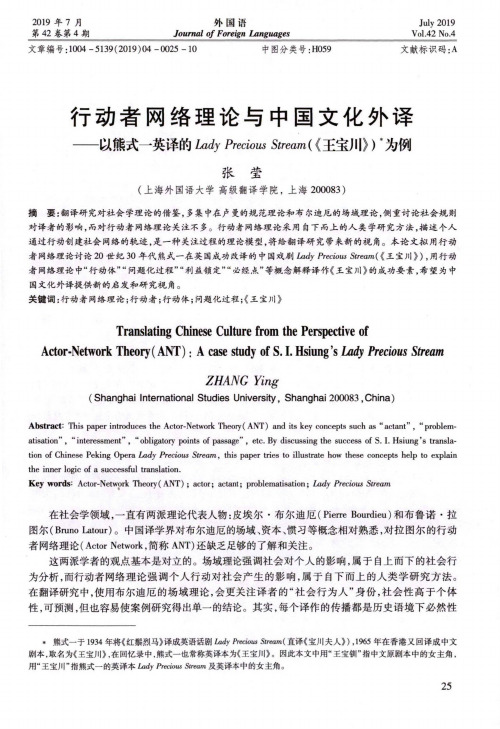
2019年7月第42卷第4期外国语Journal of Foreign LanguagesJuly 2019Vol.42 No.4文章编号:1004 - 5139(2019)04 - 0025 -10 中图分类号:H059文献标识码:A行动者网络理论与中国文化外译---以熊式一英译的La办Precious《王宝川》)4为例张莹(上海外国语大学高级翻译学院,上海200083)摘要:翻译研究对社会学理论的借鉴,多集中在卢曼的规范理论和布尔迪厄的场域理论,侧重讨论社会规则 对译者的影响,而对行动者网络理论关注不多。
行动者网络理论采用自下而上的人类学研究方法,描述个人 通过行动创建社会网络的轨迹,是一种关注过程的理论模型,将给翻译研究带来新的视角。
本论文拟用行动 者网络理论讨论20世纪30年代熊式一在英国成功改译的中国戏剧ZWy Precioiu Stream(《王宝川》),用行动 者网络理论中“行动体”“问题化过程”“利益锁定”“必经点”等概念解释译作《王宝川》的成功要素,希望为中 国文化外译提供新的启发和研究视角。
关键词:行动者网络理论;行动者;行动体;问题化过程;《王宝川》Translating Chinese Culture from the Perspective ofActor-Network Theory (ANT) :A case study of S. I. Hsiung's L ady P recious StreamZHANG Ying(Shanghai International Studies University, Shanghai 200083,China)Abstract: This paper introduces the Actor-Network Theory(ANT) and its key concepts such as “actant”,“problem- atisation” , “interessment” , “obligatory points of passage”,etc. By discussing the success of S.I. Hsiung’s transla- tion of Chinese Peking Opera Lady Precious Stream,this paper tries to illustrate how these concepts help to explain the inner logic of a successful translation.Key words' Actor-Network Theory (ANT) ;actor;actant;problematisation ;Lady Precious Stream在社会学领域,一直有两派理论代表人物:皮埃尔•布尔迪厄(Pierre Bourdieu)和布鲁诺•拉 图尔(Bruno Latcmr)。
传统文化汉语英语作文模板
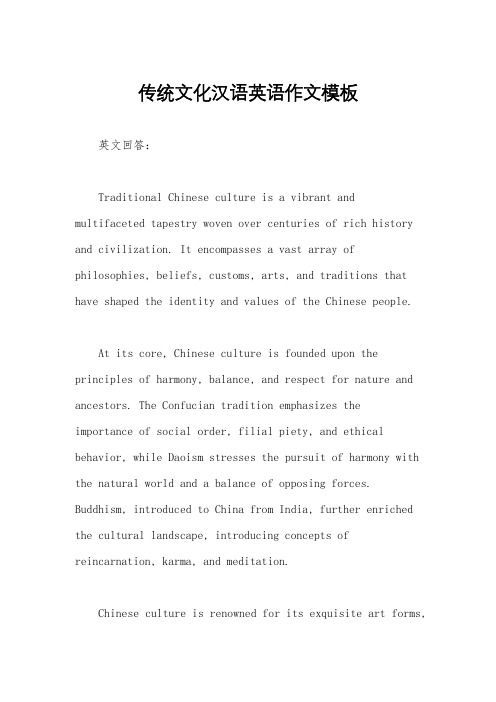
传统文化汉语英语作文模板英文回答:Traditional Chinese culture is a vibrant andmultifaceted tapestry woven over centuries of rich history and civilization. It encompasses a vast array of philosophies, beliefs, customs, arts, and traditions that have shaped the identity and values of the Chinese people.At its core, Chinese culture is founded upon the principles of harmony, balance, and respect for nature and ancestors. The Confucian tradition emphasizes theimportance of social order, filial piety, and ethical behavior, while Daoism stresses the pursuit of harmony with the natural world and a balance of opposing forces. Buddhism, introduced to China from India, further enriched the cultural landscape, introducing concepts of reincarnation, karma, and meditation.Chinese culture is renowned for its exquisite art forms,including calligraphy, painting, music, and dance. The artof calligraphy, considered a form of meditation, involves the skillful wielding of a brush to create beautiful characters. Traditional Chinese painting emphasizes the depiction of nature through a series of brushstrokes and washes of color. Chinese music is characterized by its useof pentatonic scales and unique instruments such as the guzheng and pipa.Traditional Chinese customs and festivals are deeply rooted in the country's history and beliefs. The Lunar New Year is a major celebration that marks the beginning of the new year and is characterized by family reunions, feasts, and fireworks. The Dragon Boat Festival commemorates the poet Qu Yuan, and the Mid-Autumn Festival is a time for families to gather under the full moon and share mooncakes.中文回答:中华传统文化是一幅五彩缤纷、博大精深的画卷,它凝聚了数千年的文明历史。
国家社科中华学术外译项目
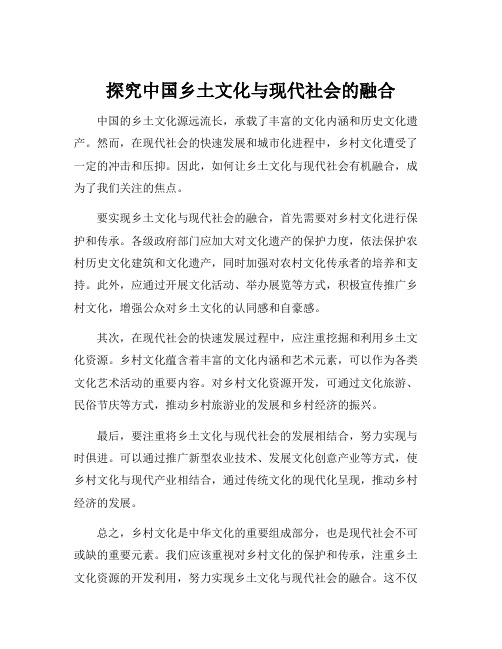
探究中国乡土文化与现代社会的融合
中国的乡土文化源远流长,承载了丰富的文化内涵和历史文化遗产。
然而,在现代社会的快速发展和城市化进程中,乡村文化遭受了一定的冲击和压抑。
因此,如何让乡土文化与现代社会有机融合,成为了我们关注的焦点。
要实现乡土文化与现代社会的融合,首先需要对乡村文化进行保护和传承。
各级政府部门应加大对文化遗产的保护力度,依法保护农村历史文化建筑和文化遗产,同时加强对农村文化传承者的培养和支持。
此外,应通过开展文化活动、举办展览等方式,积极宣传推广乡村文化,增强公众对乡土文化的认同感和自豪感。
其次,在现代社会的快速发展过程中,应注重挖掘和利用乡土文化资源。
乡村文化蕴含着丰富的文化内涵和艺术元素,可以作为各类文化艺术活动的重要内容。
对乡村文化资源开发,可通过文化旅游、民俗节庆等方式,推动乡村旅游业的发展和乡村经济的振兴。
最后,要注重将乡土文化与现代社会的发展相结合,努力实现与时俱进。
可以通过推广新型农业技术、发展文化创意产业等方式,使乡村文化与现代产业相结合,通过传统文化的现代化呈现,推动乡村经济的发展。
总之,乡村文化是中华文化的重要组成部分,也是现代社会不可或缺的重要元素。
我们应该重视对乡村文化的保护和传承,注重乡土文化资源的开发利用,努力实现乡土文化与现代社会的融合。
这不仅
有助于保护和传承乡村文化,也可以促进乡村经济的健康发展,推动中国文化的繁荣和发展。
从语用视角看中国文化经典的外译——以京剧《三堂会审》英译本为例
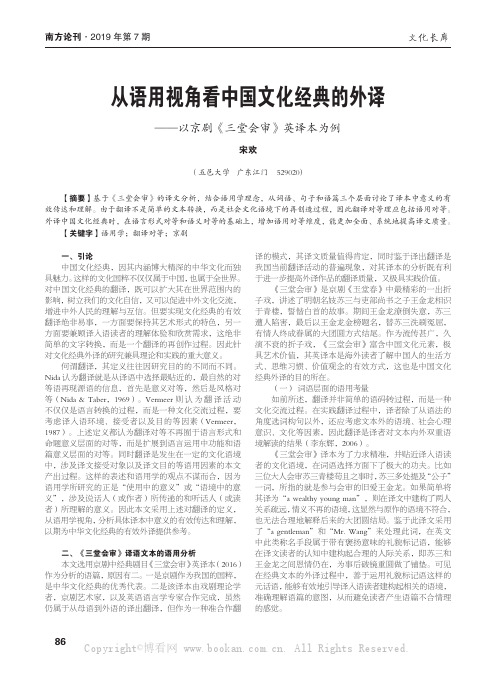
86一、引论中国文化经典,因其内涵博大精深的中华文化而独具魅力。
这样的文化国粹不仅仅属于中国,也属于全世界。
对中国文化经典的翻译,既可以扩大其在世界范围内的影响,树立我们的文化自信,又可以促进中外文化交流,增进中外人民的理解与互信。
但要实现文化经典的有效翻译绝非易事,一方面要保持其艺术形式的特色,另一方面要兼顾译入语读者的理解体验和欣赏需求,这绝非简单的文字转换,而是一个翻译的再创作过程。
因此针对文化经典外译的研究兼具理论和实践的重大意义。
何谓翻译,其定义往往因研究目的的不同而不同。
Nida 认为翻译就是从译语中选择最贴近的,最自然的对等语再现源语的信息,首先是意义对等,然后是风格对等(Nida & Taber,1969)。
Vermeer 则认为翻译活动不仅仅是语言转换的过程,而是一种文化交流过程,要考虑译入语环境、接受者以及目的等因素(Vermeer,1987)。
上述定义都认为翻译对等不再囿于语言形式和命题意义层面的对等,而是扩展到语言运用中功能和语篇意义层面的对等。
同时翻译是发生在一定的文化语境中,涉及译文接受对象以及译文目的等语用因素的本文产出过程。
这样的表述和语用学的观点不谋而合,因为语用学所研究的正是“使用中的意义”或“语境中的意义”,涉及说话人(或作者)所传递的和听话人(或读者)所理解的意义。
因此本文采用上述对翻译的定义,从语用学视角,分析具体译本中意义的有效传达和理解,以期为中华文化经典的有效外译提供参考。
二、《三堂会审》译语文本的语用分析本文选用京剧中经典剧目《三堂会审》英译本(2016)作为分析的语篇,原因有二。
一是京剧作为我国的国粹,是中华文化经典的优秀代表。
二是该译本由戏剧理论学者,京剧艺术家,以及英语语言学专家合作完成,虽然仍属于从母语到外语的译出翻译,但作为一种准合作翻译的模式,其译文质量值得肯定,同时鉴于译出翻译是我国当前翻译活动的普遍现象,对其译本的分析既有利于进一步提高外译作品的翻译质量,又极具实践价值。
中国文化内涵及其外译要旨
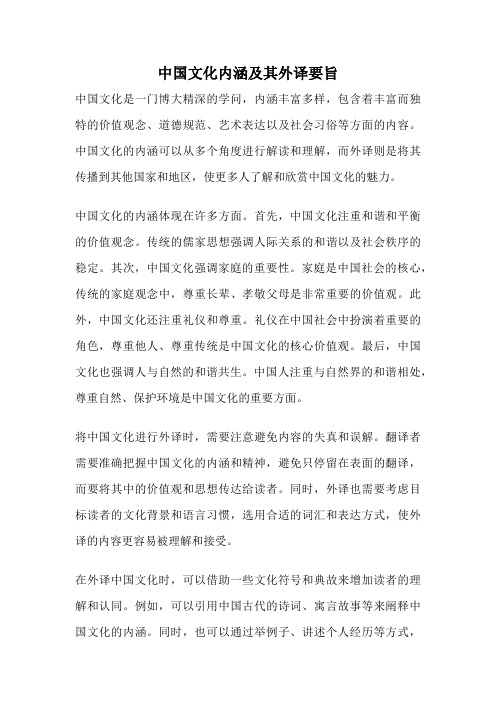
中国文化内涵及其外译要旨中国文化是一门博大精深的学问,内涵丰富多样,包含着丰富而独特的价值观念、道德规范、艺术表达以及社会习俗等方面的内容。
中国文化的内涵可以从多个角度进行解读和理解,而外译则是将其传播到其他国家和地区,使更多人了解和欣赏中国文化的魅力。
中国文化的内涵体现在许多方面。
首先,中国文化注重和谐和平衡的价值观念。
传统的儒家思想强调人际关系的和谐以及社会秩序的稳定。
其次,中国文化强调家庭的重要性。
家庭是中国社会的核心,传统的家庭观念中,尊重长辈、孝敬父母是非常重要的价值观。
此外,中国文化还注重礼仪和尊重。
礼仪在中国社会中扮演着重要的角色,尊重他人、尊重传统是中国文化的核心价值观。
最后,中国文化也强调人与自然的和谐共生。
中国人注重与自然界的和谐相处,尊重自然、保护环境是中国文化的重要方面。
将中国文化进行外译时,需要注意避免内容的失真和误解。
翻译者需要准确把握中国文化的内涵和精神,避免只停留在表面的翻译,而要将其中的价值观和思想传达给读者。
同时,外译也需要考虑目标读者的文化背景和语言习惯,选用合适的词汇和表达方式,使外译的内容更容易被理解和接受。
在外译中国文化时,可以借助一些文化符号和典故来增加读者的理解和认同。
例如,可以引用中国古代的诗词、寓言故事等来阐释中国文化的内涵。
同时,也可以通过举例子、讲述个人经历等方式,使外译更具有亲身感和情感色彩,引起读者的共鸣和兴趣。
中国文化的内涵丰富多样,包含着深厚的价值观念、道德规范和艺术表达等方面的内容。
在进行外译时,需要准确传达中国文化的精神和价值观,避免内容的失真和误解。
同时,外译也需要考虑读者的文化背景和语言习惯,选用合适的词汇和表达方式,使外译更容易被理解和接受。
通过准确无误的外译,可以让更多的人了解和欣赏中国文化的独特魅力。
- 1、下载文档前请自行甄别文档内容的完整性,平台不提供额外的编辑、内容补充、找答案等附加服务。
- 2、"仅部分预览"的文档,不可在线预览部分如存在完整性等问题,可反馈申请退款(可完整预览的文档不适用该条件!)。
- 3、如文档侵犯您的权益,请联系客服反馈,我们会尽快为您处理(人工客服工作时间:9:00-18:30)。
山东农业大学外国语学院《中国文化外译》课程论文论文题目:汉语语义模糊数字及在诗词中的翻译姓名:胡芳芳班级:英语五班学号:20104228日期:2010-7-3Translation of Chinese Numerals with SemanticFuzzinessHU Fangfang(College of Foreign Languages, Shandong Agricultural University, Tai’ an 271018) Abstract: Accuracy and clarity are usually regarded as the ideal goals for all the language users to achieve in their expressions of what in minds. However, due to various objective and subjective factors, the phenomena of fuzziness exist widely in all aspects of all the natural languages. Being one of the important sub – systems of language, numerals naturally possess the common property of language —fuzziness. Fuzziness is one of the basic natures of languages. Numerals show their exactness as well as fuzziness in linguistics. It is a difficult point to translate the fuzzy meanings from Chinese into English; as a result, a study of their translating skills benefits the translation. The theory of fuzziness in fuzzy linguistics provides a new way for translation of numerals. In the folk language and literary works, numerals with semantic fuzziness mainly express meaning, emotion and linguistic power. On the basis of semantic fuzziness, the paper explores the three principles to translate English and Chinese numerals with as an example in Poems of Mao Tsetung as an exampl e in hope to bring lightness to study of fuzzy language and translation of numerals with semantic fuzziness.And it tries to propose six principal methods o f English translation of numerals in Chinese classical poems.Keywords: Chinese numerals; semantic fuzziness; translation in Chinese classical poems汉语语义模糊数字及在诗词中的翻译摘要:明确、清楚的语言表达通常是所有语言使用者的理想境界,然而,由于主、客观方面的种种原因,模糊现象广泛存在于人类语言之中,成为所有自然语言的一大本质特性。
作为人类语言的一个重要组成部分,数字也不可避免地具有这一特性:模糊性。
模糊语言理论为数字模糊语义翻译开辟了新的途径。
英汉数字在民间语言和文学作品中具有模糊语义,重在表义、言情、显势。
本文从英汉数字模糊语义出发,结合中国古典诗词的翻译探讨数字模糊语义的翻译原则和翻译方法,寄望于对模糊语言研究和模糊语义数字翻译研究有所启示。
关键词:模糊语义;汉语数字;中国古典诗词翻译1. 引言数是观念和符号的结合,它的基本功能是计算,但数字不独属于数学王国,它除了表示事物的数量或顺序外,还广泛应用于成语或词组中,作为夸张或比喻的修辞手段,使语言凝炼生动、生辉添色,达到言简意赅,渲染气氛的效果。
在人们心灵的语言世界里,它的功能是表义,许多数字经过泛化,抒情达意、增强语势,是虚数。
这种泛化的虚数,就是数字的语义模糊现象。
美国教授查德( L. A. Zadch) 提出的“模糊语言”的理论,在语言学界曾引起过广泛的关注,它为语言科学的研究,同时也为翻译理论的研究和实践提供了新的思路。
中国古典诗词中使用大量具有模糊性的词语特别是数字,使语言更形象、生动,能创造出一种模糊美的意境。
中国古典诗词中正是使用了语言的这种模糊性提高了语言的表达效果 ,同时传递了丰富的美感信息,它所产生的美学效应能使读者获得内蕴丰富、意味深长的美的享受,使人产生一种情意领略不尽、余韵袅袅不绝的模糊审美快感。
本文结合中国古典诗词中模糊数字的英译来研究英汉语义模糊数字的翻译原则和翻译方法。
2. 英汉数字模糊语义的翻译原则“翻译不是字当句对,而是保留语言的总风格和力量,按分量而不是按数量译词。
”(王秉钦,1998:135)。
由于英汉语言差异、英汉文化差异和语境等因素的制约,英汉数字的翻译不能局限于数字本身的数值,而重在译出其寓意、译出其形象、译出其语势,译出其韵味。
鉴于此,英汉数字模糊语义的翻译应遵循三个原则:民族性原则,通俗性原则和形象性原则。
(包惠南,2003:P203-205)。
2.1 民族性原则语言是文化的载体,作为语言组成部分的数字当然积淀着丰厚的民族文化。
数字模糊语义是历史上民族文化长期积淀的结果,有着深刻的民族文化的烙印,具有鲜明的民族性(孙静,秦莉,2005:270),翻译时考虑英汉民族文化心理和语言习惯,遵循民族性原则。
如毛泽东诗词中:看万山红遍,层林尽染。
(《沁园春·长沙》)Lo! Ten thousand mountains are clothed in redWith serried maples all dyed through.(辜正坤译)遵循民族性原则,诗句中的“万”直译为―ten thousand‖。
汉语中的万、百、千和百万是表示数量之多的典型语义模糊数字;而英语中则常用hundred, thousand, million 和源于阿拉伯《一千零一夜》的one thousand and one。
汉语中的“万”在英语中用的很少,因为英语中没有万这一计量单位,而用ten thousand又不方便。
2.2 通俗性原则英汉语言中含有模糊数字的表达是人们长期使用且有定式的语句,言简意赅,通俗易懂,翻译时不能强求数字的字面对等,而应以习惯为原则,注意用词通俗,遵循通俗性原则。
如:指点江山,激扬文字,粪土当年万户侯。
(《沁园春·长沙》)We criticized the state affairs then,With vigorous strokes of the pen,To us, nothing but dung was those big men! (辜正坤译)We pointed the finger at our land,We praised and condemned through our writings,And those in high positions we counted no more than dust. (Andrew Boyd & Gladys Yang 译)译者把表示中国封建时期高官的―万户侯‖分别翻译为―those big men‖和―those in high positions‖,言简表义,用词通俗,便于英语读者理解。
2.3 形象性原则英汉数字模糊语义或源于典故,或出自宗教,或与人们的生活密切相关,一般多具有内涵丰富的形象意义,使得英汉表达更为生动和鲜明,翻译时应超越数字的实指语义而悉心捕捉数字与其他词汇结合所产生的形象寓意,遵循形象性原则。
如:敌军围困万千重,我自岿然不动。
(《西江月·井冈山》)Though enemies encircle us in a ring after ring,Nothing can leave us stirred.(辜正坤译)Surrounded ring upon ring by the foe,Aloft we still stand fast.(许渊冲译)模糊数字表达“万千”分别翻译为―a ring after ring‖和―ring upon ring‖,在表达红军不畏强敌的英雄气魄的同时,更能扩大人们的思维空间,给人以无限遐想,使句子更具有感染力,赋予语言无限的艺术之美。
这是用精确语言的描写和刻画都无法与之相比的。
3. 模糊数字在中国古典诗歌中的翻译模糊数字的巧妙运用给诗歌带来了巨大的艺术感染力,使读者感到妙趣横生、韵味无穷。
然而由于受民族心理、宗教信仰、语言崇拜等文化差异的影响,英汉语数字泛化的内涵和外延,虽有共性,但也存在着一些差异。
因此在古诗英译时,为了使译文在内容上忠实、在语句上流畅、在风格上贴切,诗歌中模糊数字的翻译需要遵循民族性、通俗性和形象性三大原则,根据情况灵活处理[3] 。
3.1 完全照数直译法。
在不影响理解的情况下, 可采用数字保留法进行直译, 尽可能真实准确地再现原文特色, 这也是翻译应该遵循的基本原则。
现略举数例:①(朝辞白帝彩云间, ) 千里江陵一日还。
(李白《早发白帝城》) 。
―I’ve sailed a thousand li through canyons in a day.‖(许渊冲,1997:240)。
②(烽火连三月,) 家书抵万金。
(杜甫《春望》)―…A family letter is worth ten thousand gold in price.‖(孙大雨,1997:160)。
③(梁园日暮乱飞鸦,) 极目萧条三两家。
(岑参《山房春事》)―…As far as eyes can see, there’re two houses or three.‖(许渊冲,2000:35)。
